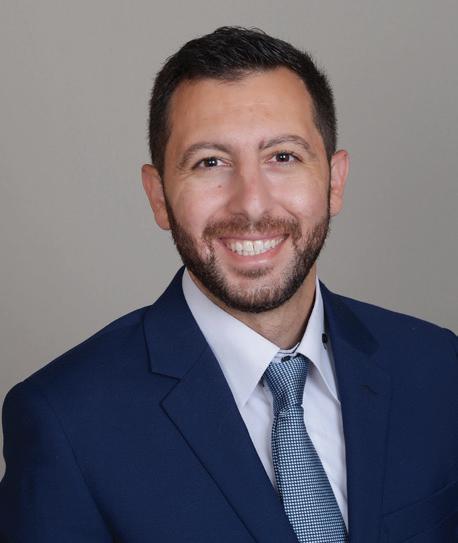
3 minute read
KARLA FONSECA PARDO
Arizona State University
Paolapark@arizona.edu
Advertisement
Karla Fonseca was born and raised in Phoenix, Arizona, to parents from Nayarit, Mexico. She is extremely proud of her culture, values, and experiences, which have been greatly influential in her life and her decision to pursue medicine. Karla is an arising senior at Arizona State University and is studying medical microbiology. After completing her undergraduate studies, Karla plans on attending the University of Arizona College of MedicinePhoenix and is interested in the specialties of oncology and family medicine. As a physician, Karla would like to work with minorities and members of underserved communities in Phoenix. She aims to reduce the language barrier between providers and patients and provide compassionate care.
Currently, Karla is an assistant TA for the microbiology labs at ASU and enjoys working with bacteria. She is also a medical scribe at an accident-related injury clinic. During her free time, Karla enjoys studying, cooking, and volunteering at her local soup kitchen and at the Mobile Health Clinic.
⊲ PROJECT Neuroblastoma Summary
Neuroblastoma is the most common form of extracranial tumor that arises from neural crest progenitor cells that form the sympathetic nervous system. This form of pediatric cancer can be classified into three categories: low risk, intermediate risk, and high risk. Patients with high-risk neuroblastoma have a worse prognosis and 5-year survival rate compared to low and intermediate risk patients. In high-risk neuroblastoma, the proto-oncogene MYCN is amplified, which drives cell proliferation and blocks differentiation. The standard treatments for patients with MYCN-amplified neuroblastoma such as chemotherapy and surgery are ineffective, and require more effective targeted treatments. The tumor suppressor gene Inhibitor of Growth 4 (ING4) has been shown to be mutated in neuroblastoma cell lines. The relationship between ING4 and MYCN in neuroblastoma is not yet clearly understood.
In this study, we will assess whether ING4 affects cell proliferation and morphology in the non-MYCN amplified neuroblastoma cell line SK-N-AS. Proliferation assays will be used to determine the proliferation rate of vector control PMIG cells and ING4-overexpressing cells. Changes in cell morphology will also be assessed based on cluster formation (number, size, and network projections). Understanding the relationship between MCYN and ING4 will allow us to develop better targeted treatments for patients exhibiting high-risk neuroblastoma and improve their prognoses.
Suwon Kim
PhD
Associate Professor, Basic Medical Sciences
Suwon@arizona.edu
Suwon Kim is an Associate Professor at the University of Arizona College of MedicinePhoenix and the Translational Genomics Research Institute. Dr. Kim obtained her undergraduate degree from University of California Berkeley and her PhD from Yale University School of Medicine. She completed her postdoctoral research in the laboratory of Dr. J. Michael Bishop at University of California San Francisco. Dr. Kim’s research focuses on oncogenes and tumor suppressors that play a role in the emergence and therapy-resistant recurrence of breast cancer. One of her main projects is to characterize the ING4 tumor suppressor related to its functions in chromatin remodeling, transcriptional regulation, and tumor immune microenvironment modulation.

Airen James Fortunado
University of Arizona
Airenjf@arizona.edu
Airen Fortunato is a rising junior at the University of Arizona studying Neuroscience & Cognitive Science with minors in biochemistry and classics. Airen is a first-generation college student who was born in Chandler Arizona, before moving and being raised in Maricopa, Arizona. He is interested in pursuing a career as a physician scientist and seeks to combine his passion for science and medicine to help advance medical research and serve populations that are often disadvantaged and lack access to quality healthcare, particularly in those in rural areas like he grew up in. Airen enjoys hiking, reading, and playing guitar in his free time.
⊲ PROJECT
Efficacy of inhibitors of SARS-CoV-2 RNA Polymerase Subunits
Description: The SARS-CoV-2 virus replicates itself in host cells using an RNA dependent RNA polymerase (RdRp). The RdRp of SARS-CoV-2 consists of 3 protein subunits that provide it functionality. The subunits are Nonstructural Proteins (NSP) 7, NSP8, and NSP12. When assembled, there are 2 NSP8 proteins, 1 NSP12 protein, and one NSP7 protein. Preventing the formation of SARS-CoV-2’s RdRp would be an effective mechanism of action for an antiviral treatment of COVID-19. Designing compounds that could inhibit the SARS-CoV-2 RdRp could then provide a novel form of treatment.
This project assesses an RdRp inhibitor and its efficacy in preventing the binding of NSP8 and NSP12, the proteins which possess the catalytic domains of RdRp. The RdRp inhibitor acts by binding to NSP12 and preventing the association of NSP8, thus preventing RNA replication. An ideal candidate for SARS-CoV-2 antiviral treatment will exhibit dose response behavior. Using protein-protein interaction assays, the efficacy of the RdRp inhibitor can be determined.





